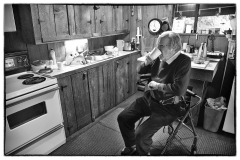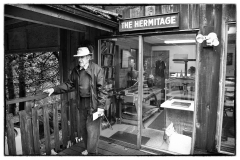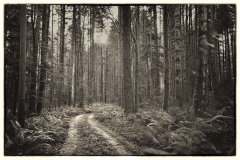Regional district staff recommend approving an amended application for groundwater extraction in Merville as a “home occupation,” but rural area directors want more clarity on its legal definition

Obituary: Fr. Charles Brandt, first Catholic hermit priest in several hundred years
Fr. Charles in his studio at The Hermitage | George Le Masurier photo
Obituary: Fr. Charles Brandt, first Catholic hermit priest in several hundred years
Written by Bruce Witzel
Rev. Charles Brandt noted conservationist, hermit monk, and priest of the Diocese of Victoria, died in the early hours of Sunday, October 25. A spiritual guide and inspiration to many beyond the Catholic Church, Charles was in the North Island Hospital in Comox Valley at the time of his death from pneumonia. He was in his 97th year.
Father Brandt lived for nearly five decades at his forested hermitage next to Oyster River. In 2019, those 27 acres were put into a permanent land conservancy and Charles has bequeathed the property to the Comox Valley Regional District for use as a public park. An active contemplative person of prayer who has concern for the Sacred Commons will live in the hermitage to follow in Charles’ footsteps.
Brandt was the sole surviving member of a unique hermit community originally established in 1964 near the Tsolum River in Merville, B.C. Bishop Remi De Roo ordained Brandt in 1966 as the first hermit priest in several hundred years within the Roman Catholic Church. This
eremitical tradition had fallen into disuse in western churches after the Reformation and was reconstituted through later reforms of the Second Vatican Council 1962-65, in which a young Remi De Roo participated.
 Brandt was in communication with world-famous Trappist monk and author, Thomas Merton, about joining the community on Vancouver Island in 1968 at the time of Merton's death. Brandt had originally entered monastic life as a Trappist at New Melleray, Iowa.
Brandt was in communication with world-famous Trappist monk and author, Thomas Merton, about joining the community on Vancouver Island in 1968 at the time of Merton's death. Brandt had originally entered monastic life as a Trappist at New Melleray, Iowa.
Brandt earned his keep as an art and paper conservationist by setting up a special lab at his hermitage. He gained world renown for restoring many historical books like The Nuremberg Chronicles printed in 1493, many older bibles, and one of the original books of The Audubon Series.
He taught Christian meditation practice at the hermitage and led other retreats, inspiring many people over the decades. He occasionally filled in as a parish priest in The Comox Valley and Campbell River.
Father Brandt rose at 3 AM to meditate, read psalms and practice daily liturgy. During early hours, he often meandered into nature to observe birds and wildlife and to take photographs. In his book Self and Environment, he describes this walking meditation as a time when “Every atom of my being is present to every atom in the universe, and they to it.”
In later years, Brandt was much celebrated in public ways which included media profiles and reports on his pioneer environmental work. He is credited with heading up the effort that saved the Tsolum River from industrial degradation.
His stature as a spiritual teacher as well as his whole legendary reputation as someone who integrated spirituality with ecology will live on after him in the lives and efforts of the many people he directly inspired.
Fr. Charles is survived by his sister-in-law, Wanda Brandt, and numerous nephews, nieces and their children and grandchildren in the Kansas City area and around the United States. He was predeceased by his parents, Anna (nee Bridges) and Alvin Brandt, brothers Frank and Chet, and sisters Frances, Mary and Ella.
Donations in remembrance of Charles can be made to St. Andrews Cathedral in Victoria, the Tsolum River Restoration Society, Comox Valley Nature Society, the Oyster River Enhancement Society or the Brandt Oyster River Hermitage Society.
FURTHER READING: A Long and Winding Journey
SUBSCRIBE TO OUR NEWSLETTER
On Merville groundwater extraction it’s deja vu all over again
Merville water bottling issue returns to the CVRD, highlights provincial water policies
The Comox Valley Electoral Areas Service Commission will consider on Monday an amended application for water bottling operations in Merville and draw attention to larger water policy issues in British Columbia
What’s dire: the lack of Comox subdivisions or climate change and gradual deforestation?
A Comox Valley developer is suing the Town of Comox because his permits to cut down trees and build more single-family homes haven’t been issued as fast as he’s wanted and because the town wants a wider walking trail through the property
Join the discussion Oct. 3 about food system security in the Comox Valley
The Watershed Sentinel magazine is hosting a zoom webinar Oct. 3 on food system security in the Comox Valley
Comox Valley Nature webinar to discuss effect of climate change on marine life
Comox Valley Nature lecture to discuss how this summer’s heatwave killed off billions of sea life and the future for marine ecosystems
New North Island organics processing facility raises concerns about cost, fire and odours
Campbell River environmentalists raise concerns about the the cost and location of the Comox Strathcona Waste Management Commission’s new organics processing facility
THE WEEK: 5 things wrong with how Comox tried to hide sewage spill information
Comox Town Council has nothing to say about raw sewage leaking into Brooklyn Creek beyond issuing a press release, which makes misleading statements
Tonnes of sewage mud removed from Brooklyn Creek, nearby residents say its been piling up for years
A Town of Comox infrastructure failure could have spilled raw sewage into Brooklyn Creek for a long time, according to nearby residents who have noticed unusual plant growth and sewage-type odours for nearly 24 months. Mayor and councilors say they didn’t know about it
Town of Comox spills raw sewage into Brooklyn Creek, doesn’t inform public
A broken pipe has spilled raw sewage into Brooklyn Creek and it appears that efforts to mitigate the damage have created a high level of turbidity, a double whammy for fish as well as a potential public health concern. But the Town of Comox has not yet formally informed the public.
Campbell River Environmental Committee lists its current top priorities
The Campbell River Environmental Committee has kept North Island residents aware of environmental risks and promoted awareness of potential concerns to help government and industry make informed decisions











